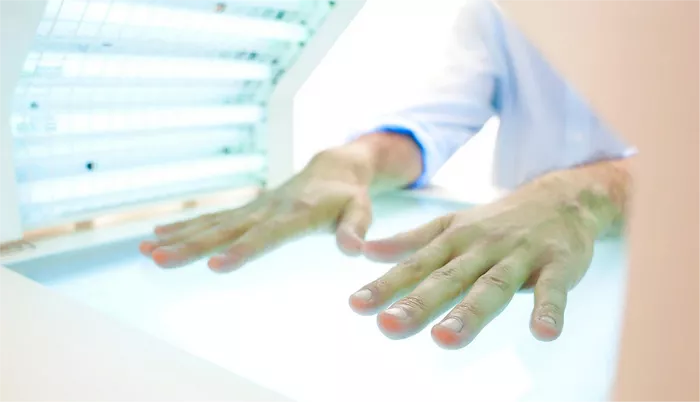Psoriasis is a chronic autoimmune condition that affects millions of people worldwide, characterized by the rapid buildup of skin cells, leading to redness, inflammation, and scaling. While there is no cure for psoriasis, various treatments aim to manage symptoms and improve quality of life for those affected. One such treatment modality that has shown efficacy is the use of ultraviolet (UV) light therapy. In this article, we delve into the mechanisms behind UV light treatment for psoriasis, its effectiveness, safety considerations, and emerging trends in this field.
What is UV Light Therapy?
UV light therapy, also known as phototherapy, involves the controlled exposure of the skin to ultraviolet light. There are three types of UV light: UVA, UVB, and UVC. However, UVC is typically filtered out by the Earth’s atmosphere and is not used in medical treatments. Both UVA and UVB light have been found to be beneficial in the management of psoriasis.
How Does UV Light Treat Psoriasis?
The exact mechanisms by which UV light treats psoriasis are not fully understood, but several hypotheses have been proposed. UVB therapy is thought to work by slowing down the rapid growth of skin cells and reducing inflammation. UVB light penetrates the skin and suppresses the immune system’s overactivity, which plays a central role in the development of psoriatic lesions.
UVA therapy, on the other hand, is often used in combination with a photosensitizing medication called psoralen (PUVA therapy). Psoralen makes the skin more sensitive to UVA light, enhancing its therapeutic effects. UVA light is believed to target T cells in the skin, which are involved in the inflammatory response seen in psoriasis. By modulating the activity of these immune cells, UVA therapy helps to alleviate symptoms and promote skin clearance.
Effectiveness of UV Light Therapy
Numerous studies have demonstrated the effectiveness of UV light therapy in the treatment of psoriasis. UVB therapy, in particular, has been shown to induce significant improvements in symptoms, including reduced redness, scaling, and thickness of plaques. PUVA therapy is often reserved for cases of severe psoriasis or when other treatments have failed to provide adequate relief. When used appropriately, PUVA therapy can achieve high rates of skin clearance and prolonged remission periods.
The effectiveness of UV light therapy can vary depending on factors such as the type and severity of psoriasis, the individual’s skin type, and the treatment regimen. Some patients may experience rapid improvement in symptoms after just a few sessions, while others may require more prolonged treatment to see results. It is essential for patients to work closely with their healthcare providers to determine the most appropriate treatment plan for their specific needs.
Safety Considerations
While UV light therapy can be highly effective for treating psoriasis, it is not without risks. Prolonged or excessive exposure to UV radiation can increase the risk of skin damage, including sunburn, premature aging, and skin cancer. Therefore, it is crucial for patients undergoing UV light therapy to follow strict protocols and safety guidelines to minimize these risks.
Dermatologists carefully monitor the duration and intensity of UV exposure during treatment sessions to ensure that patients receive the maximum benefit with minimal risk of adverse effects. Protective measures such as goggles and shielding of sensitive areas are often employed to prevent damage to the eyes and surrounding healthy skin.
It is also essential for patients undergoing UV light therapy to avoid excessive sun exposure and to use sunscreen regularly to protect their skin from further damage. Additionally, individuals with a history of skin cancer or those at high risk for developing it may not be suitable candidates for UV light therapy and should explore alternative treatment options.
Emerging Trends and Innovations
In recent years, significant advancements have been made in the field of UV light therapy for psoriasis. One notable trend is the development of targeted phototherapy devices that deliver UV light specifically to affected areas of the skin, minimizing exposure to healthy tissue. These devices allow for more precise and efficient treatment, reducing the risk of side effects associated with conventional phototherapy.
Another emerging innovation is the use of home-based phototherapy units, which allow patients to undergo treatment in the comfort of their own homes under the guidance of their healthcare providers. Home phototherapy has been shown to be as effective as clinic-based treatment for many patients, offering greater convenience and flexibility without compromising safety or efficacy.
Furthermore, ongoing research is exploring the potential of adjunctive therapies to enhance the efficacy of UV light therapy for psoriasis. Combination treatments involving UV light and medications such as retinoids, calcineurin inhibitors, and biologic agents show promise in achieving better outcomes and prolonged remission periods for patients with moderate to severe psoriasis.
Conclusion
UV light therapy remains a cornerstone in the management of psoriasis, offering a safe and effective treatment option for many patients. By targeting the underlying mechanisms of the disease, UV light helps to alleviate symptoms, reduce inflammation, and promote skin clearance. With careful monitoring and adherence to safety guidelines, UV light therapy can significantly improve the quality of life for individuals living with psoriasis. As research continues to advance, further innovations in phototherapy hold the promise of even better outcomes for patients in the future.

























